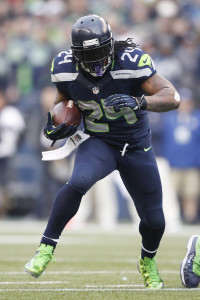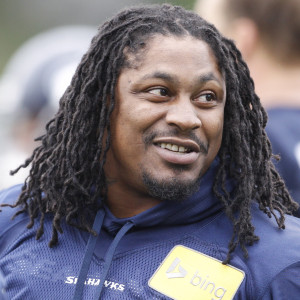The Broncos giving Jamaal Charles an opportunity represented a key step for the high-profile free agent running backs. After a complicated offseason for just about every big-name back in search of a new home, the 30-plus contingent of this group found new homes in quick succession.
 LeGarrette Blount still needs a new employer, but after the Charles/Adrian Peterson/Marshawn Lynch troika agreed to terms, the 30-year-old’s price range will presumably narrow. With Peterson, Lynch and Charles each being attached to accords worth around $3MM AAV for 2017, with various incentives looming as critical deal points, the 30-year-old Blount may follow suit soon now that the market has essentially been set.
LeGarrette Blount still needs a new employer, but after the Charles/Adrian Peterson/Marshawn Lynch troika agreed to terms, the 30-year-old’s price range will presumably narrow. With Peterson, Lynch and Charles each being attached to accords worth around $3MM AAV for 2017, with various incentives looming as critical deal points, the 30-year-old Blount may follow suit soon now that the market has essentially been set.
But it’s certainly going to be a change of pace for each of the trio that’s already signed. Each will transition from being his team’s clear-cut No. 1 running back to a cog in backfields that aren’t as certain to be geared around these players.
The Vikings, Seahawks and Chiefs received top-of-the-line production from these three dynamos during the first half of this decade, but the Saints, Raiders and Broncos, respectively, will expect less of them in 2017. How much less is the key question.
Lynch appears to have the clearest road to a steady role, with Oakland prioritizing the 31-year-old recently unretired back instead of diverting resources to a younger ball-carrier in a loaded draft. He’s also going to have a chance to run behind a high-end Raiders offensive front. But Beast Mode has not played a full season since 2014 and will be more than 18 months removed from his last NFL game by the time he suits up in Week 1.
Oakland also has multiple change-of-pace backs in DeAndre Washington and Jalen Richard that boasted per-carry averages well north of 5.0 as rookies. Lynch steamrolled his way to four Pro Bowls in Seattle and averaged 4.7 yards per tote in 2014 but struggled a year later to a 3.8-per-handoff average. While the Seahawks’ embattled offensive line can be singled out as a key reason for this production dip for Lynch, Thomas Rawls (5.6 ypc in ’15) looked better by comparison in the pair’s lone season together. The Raiders will deploy a much better array of blockers than did the ’15 Seahawks, but by eschewing younger investments at this young man’s position this offseason, they’re still gambling Lynch can operate at close to his Seahawks form. The Raiders are pleased by Lynch’s condition thus far, at least.
 Peterson figures to team with Mark Ingram in New Orleans, but with Ingram being used frequently in the Saints’ passing game the past two seasons, the former Vikings All-Pro’s role will be interesting to observe. Peterson has functioned best as a pure runner since returning from his ACL tear in 2012. While the 32-year-old UFA addition might still be a better ground operator than Ingram when healthy, he struggled behind a porous Vikes offensive line in 2016. Averaging a ghastly 1.9 yards per carry during a season that saw Peterson tear his meniscus, the future Hall of Famer will have to prove he can make another comeback but do so at an age where most running backs are out of the game.
Peterson figures to team with Mark Ingram in New Orleans, but with Ingram being used frequently in the Saints’ passing game the past two seasons, the former Vikings All-Pro’s role will be interesting to observe. Peterson has functioned best as a pure runner since returning from his ACL tear in 2012. While the 32-year-old UFA addition might still be a better ground operator than Ingram when healthy, he struggled behind a porous Vikes offensive line in 2016. Averaging a ghastly 1.9 yards per carry during a season that saw Peterson tear his meniscus, the future Hall of Famer will have to prove he can make another comeback but do so at an age where most running backs are out of the game.
That said, Peterson offered maybe the greatest comeback season for a skill-position player in memory in compiling that 2,097-yard slate five years ago. He then won the 2015 rushing title after the near-season-long 2014 suspension. Drew Brees‘ explosive offense, which ranked No. 1 last season, will help divert defenses from concentrating on stopping Peterson the way Minnesota opponents could for years. Alvin Kamara‘s potential place in this backfield could be a big factor as well, but the Tennessee rookie may carve into the team’s extensive passing-down work instead of exclusively cutting into Peterson’s handoff count.
Charles may bring the highest variance of the acclaimed trio. The Chiefs’ all-time rushing leader will easily be the most accomplished running back on the Broncos’ roster, but he’s obviously missed extensive time the past two years due to knee injuries and is a threat to not make it back at all. Mike Klis of 9News reported Charles was “90 percent” healthy on his signing day. As a result, the NFL’s all-time yards-per-carry king received the smallest financial commitment, at $1MM base value, comparatively. However, at 30 — and with nearly 1,000 fewer career carries (1,332) than Peterson (2,418) and Lynch (2,144) — Charles is the youngest of the three and has a skill set his Bronco mates don’t.
He of a 70-catch season in 2013, the two-time first-team All-Pro has a clear avenue toward the Broncos’ passing-down responsibilities — with the obvious health caveat representing the only barrier. C.J. Anderson is also coming off a severe knee injury. The fifth-year player remains expected to start, but the between-the-tackles grinder hasn’t shown himself to be the type of back Charles has when healthy. The Broncos don’t have an upper-echelon offensive line, but Charles hasn’t been afforded that luxury much in his career and has never finished a season averaging fewer than 5.0 yards per rush. While he surmounted a 2011 ACL tear to re-emerge with dominant 2012 and ’13 campaigns, the veteran now has to do that at an older age and with a more extensive medical history.
There are a lot of moving parts to these stalwarts’ situations, but each certainly has upside. Who do you think will make the biggest impact for his new team this season? Will Charles’ open-field skills make him a bigger weapon than his run-centric peers? Or will Lynch’s comeback tour succeed behind an offensive line featuring three Pro Bowlers? Will Peterson capitalize on Brees and Co.’s setup and prove everyone wrong again? Take PFR’s latest poll and weigh in with your thoughts in the comments section about what should be an interesting year for the running back position.

